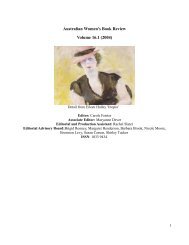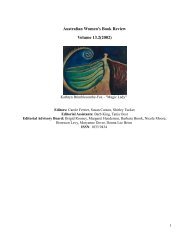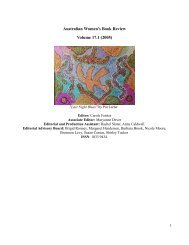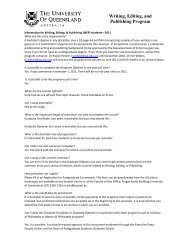Australian Women's Book Review Volume 14.1 - School of English ...
Australian Women's Book Review Volume 14.1 - School of English ...
Australian Women's Book Review Volume 14.1 - School of English ...
You also want an ePaper? Increase the reach of your titles
YUMPU automatically turns print PDFs into web optimized ePapers that Google loves.
Colonial or post-colonial religion? Reading Aboriginal Christianity<br />
Heather McDonald, Blood, Bones and Spirit: Aboriginal Christianity in an East Kimberley Town.<br />
Carlton South, VIC: Melbourne University Press, 2002.<br />
<strong>Review</strong>ed by Anne Elvey.<br />
At the beginning <strong>of</strong> Blood, Bones and Spirit, two maps, which could be<br />
overlaid one directly upon the other, show the contemporary East<br />
Kimberley region in north-western Australia. On the left hand page the<br />
region is marked with the names <strong>of</strong> European towns and stations, on the<br />
right hand page with the names <strong>of</strong> the Aboriginal communities whose place<br />
it is. The two maps in a sense act as a metaphor for a mapping that occurs<br />
throughout the text: two quite different ways <strong>of</strong> interpreting the world meet<br />
with varying degrees <strong>of</strong> conflict and appropriation when Aboriginal<br />
cultures in the East Kimberley encounter Western Christianity. Although<br />
this study is specific to a particular place in north-western Australia, Blood,<br />
Bones and Spirit addresses a key contemporary concern, not only<br />
understanding and redressing the past and the on-going violence <strong>of</strong><br />
colonisation, but to be attentive to the particular ways in which indigenous<br />
peoples and others throughout the world are negotiating with, reinterpreting<br />
and resisting colonial practices for their own survival.<br />
Roberta (Bobbi) Sykes has a poem entitled 'Rachel' commemorating the death <strong>of</strong> an eight-month-old<br />
child on Palm Island Reserve (<strong>of</strong>f the north-east coast <strong>of</strong> mainland Australia) in 1974 after a doctor's<br />
refusal to treat the child. The poem begins by recalling the arrival <strong>of</strong> the Bible in Australia as<br />
accompaniment to and agent <strong>of</strong> colonisation. Moving through a description both <strong>of</strong> the dead child,<br />
whose name Rachel comes from the Bible, and <strong>of</strong> the doctor's neglect, the poem suggests that those<br />
who brought the Bible to this land 'need to take a closer look.' Focusing on the tragedy <strong>of</strong> the child's<br />
death and the racist underpinnings <strong>of</strong> the doctor's neglect, the poem also highlights the ambiguity that<br />
surrounds Aboriginal experience <strong>of</strong> Christianity in Australia, where Christianity has come to be<br />
experienced in both colonial and counter-colonial ways by its Aboriginal adherents.<br />
In recent years, publications such as A Spirituality <strong>of</strong> Catholic Aborigines and the Struggle for Justice<br />
(Catholic Archdiocese <strong>of</strong> Brisbane: Aboriginal and Torres Strait Islander Apostolate, 1993) and the<br />
Rainbow Spirit Elders' Rainbow Spirit Theology: Towards an <strong>Australian</strong> Aboriginal Theology<br />
(Blackburn: HarperCollinsReligious, 1997) attest to some <strong>of</strong> the ways in which Aboriginal Christians in<br />
Australia have been articulating their experiences <strong>of</strong> and reinterpreting their practice <strong>of</strong> Christianity<br />
'Aboriginal way.' McDonald's approach is different. Blood, Bones and Spirit is an anthropological study<br />
undertaken as doctoral work at the <strong>Australian</strong> National University. It looks not at those Aboriginal<br />
Christian traditions, for example in the Uniting, Anglican, and Roman Catholic churches, where<br />
Indigenous participants are actively reworking the Western traditions brought by the missionaries.<br />
Rather, Blood Bones and Spirit considers the emergence <strong>of</strong> Aboriginal Christianity within two<br />
evangelical Protestant churches, the United Aborigines Mission (UAM) and the Assemblies <strong>of</strong> God<br />
(AOG) congregations in Halls Creek, a small town in the East Kimberley area. The UAM and AOG<br />
adherents there are Gija and Jaru people. Occasionally, McDonald also makes analytical comparisons<br />
with the practice <strong>of</strong> Aboriginal Christianity within the Roman Catholic community <strong>of</strong> the region.<br />
While McDonald identifies as post-Christian, she comes 'from a long family line <strong>of</strong> Christian<br />
67








